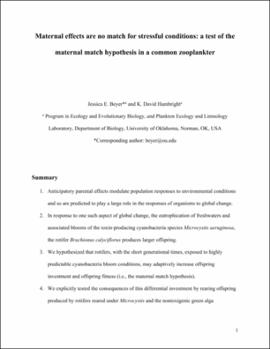| dc.contributor.author | Beyer, Jessica E. | |
| dc.contributor.author | Hambright, K. David | |
| dc.date.accessioned | 2020-10-29T16:56:41Z | |
| dc.date.available | 2020-10-29T16:56:41Z | |
| dc.date.issued | 2017-05-14 | |
| dc.identifier.citation | Beyer, J. E., and K. D. Hambright. (2017) Maternal effects are no match for stressful conditions: a test of the maternal match hypothesis in a common zooplankter. Functional Ecology 31(10): 1933-1940. https://besjournals-onlinelibrary-wiley-com.ezproxy.lib.ou.edu/doi/10.1111/1365-2435.12901 | en_US |
| dc.identifier.uri | https://hdl.handle.net/11244/325636 | |
| dc.description.abstract | Anticipatory parental effects modulate population responses to environmental conditions and so are predicted to play a large role in the responses of organisms to global change. In response to one such aspect of global change, the eutrophication of freshwaters and associated blooms of the toxin‐producing cyanobacteria species Microcystis aeruginosa, the rotifer Brachionus calyciflorus produces larger offspring. We hypothesized that rotifers, with their short generational times, exposed to highly predictable cyanobacteria bloom conditions, may adaptively increase offspring investment and offspring fitness (i.e. the maternal match hypothesis). We explicitly tested the consequences of this differential investment by rearing offspring produced by rotifers reared under Microcystis and the nontoxigenic green alga Chlamydomonas, in a full factorial design, where offspring were raised under the maternal diet or the opposite food source. We measured age‐specific fecundity, survival and population growth rates under these conditions and found that maternal exposure to Microcystis decreased offspring survival and fecundity, regardless of offspring diet. Population growth rates, tested using aster models, differed significantly among maternal and neonate diets, but there was no significant interaction between the two factors. Our evidence thus leads us to reject the maternal match hypothesis in this case of rotifer–toxigenic algal bloom interactions and provides further support that toxigenic algal blooms may have extensive effects on grazer populations in ways that are not evaluated using traditional, single‐generation experimental methods. | en_US |
| dc.description.sponsorship | Funding was provided by the Oklahoma Department of Wildlife Conservation (through the Sport Fish Restoration Program, Grant F‐61‐R to K.D.H), the University of Oklahoma Department of Biology and the University of Oklahoma Biological Station (through a Graduate Research Fellowship to J.E.B). | en_US |
| dc.language | en_US | en_US |
| dc.subject | Brachionus calyciflorus | en_US |
| dc.subject | Harmful algal blooms | en_US |
| dc.subject | Life history | en_US |
| dc.subject | Maternal match hypothesis | en_US |
| dc.subject | Optimal allocation | en_US |
| dc.subject | Rotifers | en_US |
| dc.subject | Anticipatory parental effects | en_US |
| dc.title | Maternal effects are no match for stressful conditions: a test of the maternal match hypothesis in a common zooplankter | en_US |
| dc.type | Article | en_US |
| dc.description.peerreview | Yes | en_US |
| dc.identifier.doi | 10.1111/1365-2435.12901 | en_US |
| ou.group | College of Arts and Sciences::Department of Biology | en_US |
